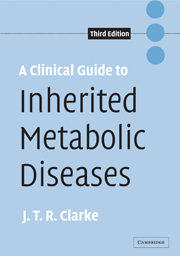Book contents
- Frontmatter
- Contents
- Reviews of first edition
- Reviews of second edition
- List of tables
- List of figures
- Preface
- 1 General principles
- 2 Neurologic syndrome
- 3 Metabolic acidosis
- 4 Hepatic syndrome
- 5 Cardiac syndromes
- 6 Storage syndrome and dysmorphism
- 7 Acute metabolic illness in the newborn
- 8 Newborn screening
- 9 Laboratory investigation
- 10 Treatment
- Index
- References
8 - Newborn screening
Published online by Cambridge University Press: 10 September 2009
- Frontmatter
- Contents
- Reviews of first edition
- Reviews of second edition
- List of tables
- List of figures
- Preface
- 1 General principles
- 2 Neurologic syndrome
- 3 Metabolic acidosis
- 4 Hepatic syndrome
- 5 Cardiac syndromes
- 6 Storage syndrome and dysmorphism
- 7 Acute metabolic illness in the newborn
- 8 Newborn screening
- 9 Laboratory investigation
- 10 Treatment
- Index
- References
Summary
Large-scale screening is a well-established way to identify members of a population, such as newborn infants, affected by a specific disease before the development of clinical signs of the condition, with the objective of initiating treatment that would prevent serious disability or even death. The initiative for most population-based screening programs rests with the state, rather than with the subject to be tested, who may not even be aware that testing is being done. In most cases, consent for testing is considered to be implied unless the individual or parent specifically objects. Therefore, the state assumes responsibility for ensuring that the facilities and resources are available to provide appropriate follow-up investigation and treatment of individuals identified by the screening program.
Screening newborn infants for PKU was the first, large-scale genetic screening initiative to be widely adopted in a direct attempt to ameliorate the impact of genetic disease. The principles that have evolved since its introduction have served as a model for the development of numerous subsequent newborn screening programs. For many years, the principles originally articulated by Wilson and Jungner for screening in general and later modified and expanded by Pollitt et al. with specific reference to newborn screening have been accepted as the criteria for neonatal screening. They are:
The condition sought should be an important health problem. This is viewed as a combination of the incidence of the condition and the consequence for the affected individual.
[…]
- Type
- Chapter
- Information
- A Clinical Guide to Inherited Metabolic Diseases , pp. 228 - 240Publisher: Cambridge University PressPrint publication year: 2005
References
- 1
- Cited by



